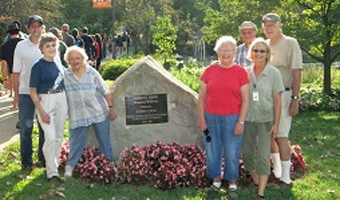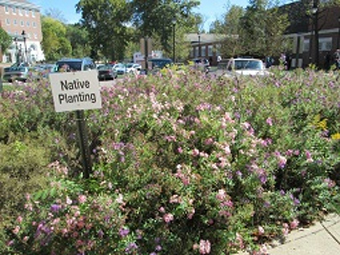By Sarah Lack
From Compass
The trees and plants that dot the landscape of Ohio University’s Athens Campus are often appreciated as part of the beauty that beckons Bobcats “home.” But look deeper, and the plants at OHIO symbolize more than just natural splendor. The tulips across campus that blossom during Commencement weekend are a symbol of the bright futures that lie ahead for OHIO’s newest alumni. The cherry trees that line the path along the Hocking River, majestically lit during their precious bloom each spring, symbolize a partnership that crosses continents. Though they can’t speak for themselves, OHIO’s plants have stories to tell.

Susan Calhoun poses with a group of emeriti volunteers as they work on the plantings at Emeriti Park on the Athens Campus.
Photo courtesy of: Susan Calhoun
For nearly 30 years, Ohio University alum Susan Calhoun, landscape coordinator with the grounds maintenance department, has been listening to those stories – and protecting them for future generations of Bobcats to hear.
Calhoun, who earned her bachelor’s degree in field biology and botany from the College of Arts & Sciences in 1985, is charged with caring for, protecting and expanding the University’s tree and plant population. She designs landscape plans, works with contractors to minimize damage during campus construction projects and coordinates the maintenance and removal of trees and plants on the Athens Campus.
“It’s no secret we have a beautiful campus; I feel pretty privileged to be a caretaker,” Calhoun said. “There is a creative element to my job that I love, and I also love working with students. I’ve taught a lot of young people how to work!”

One of several native plantings established by Calhoun and the grounds team on the Athens Campus.
Photo courtesy of: Susan Calhoun
Many lessons have been learned along the way for Calhoun and her team, whose tree work planning is driven by the goal of maintaining and expanding campus canopy cover, reducing environmental challenges like asphalt heat islands and supporting OHIO’s Sustainability Plan.
“I’ve learned to diversify the species in our plantings,” she explained. “During the 2015 season, 274 new trees were added by OHIO’s grounds department, including through contracted plantings such as the new South Green Housing Complex. Many of these trees were species native to Southeast Ohio. This large number of new trees required heightened monitoring and labor throughout 2016, especially during times of little to no rainfall in the extra dry summer and fall. The grounds employees installed and filled 20-gallon gator bags on all of the trees to provide adequate moisture each week.”
Partnering with the Office of Sustainability and Kristeena Blaser, a graduate assistant and master’s student in the Voinovich School of Leadership and Public Affairs’ environmental studies program, Calhoun worked on submitting the first Tree Campus USA application in OHIO’s history. One requirement of the program involves keeping detailed records and writing a Tree Care Plan. Protection of campus trees is a high priority – a requirement made more difficult after the emerald ash borer, an ash tree-killing insect from Asia, was found in Athens.
According to Ann Bonner, an urban forester with the Ohio Department of Natural Resources, emerald ash borer has become the most destructive forest insect to ever invade the U.S.
“Hundreds of millions of ash trees have already been killed in forests and swamps, along waterways and in urban, suburban and rural neighborhoods in 18 states, along with Ontario and Quebec,” Bonner said. “Some fear that this non-native invasive exotic pest will render native ash trees functionally extinct in our ecosystems in next few decades.”
After attending several trainings on how to mitigate the destructive pest, Calhoun made the decision to treat OHIO’s ash trees by directing a bark spray pesticide application that slowed the spread of the emerald ash borer. Calhoun stepped up the program in 2016 with a more aggressive treatment that involved injecting a pest-killing fluid directly into the ash trees, allowing it to penetrate their vascular system.
“Knowing that few entities or private land owners in the region were treating their trees, I felt compelled to try to preserve some of the ash on the Athens Campus,” Calhoun said. “So we went for the injection treatment.”
During May and June of 2016, approximately 100 ash trees on the Athens Campus were treated with the goal of protecting them from future emerald ash borer infestation. Though it is a long-term and technical task, early signs indicate that the treatment is successfully protecting OHIO’s ash trees, preserving the genetics of this native species in Southeast Ohio.
In addition to her crusade to protect OHIO’s ash trees, Calhoun and the grounds team have also implemented many native plantings across campus, including two natural prairie plantings on the Ohio University Golf Course in which a family of foxes made its home for several seasons.
“Native plantings can thrive with little maintenance,” Calhoun said. “Prairie and wildflower plantings only need to be mowed in early spring once they are established. These plantings benefit the ecosystem by providing cover and food for wildlife as well as nectar for bees and other pollinators. We planted milkweed at several sites, adding an especially large planting of Butterfly Weed at Carper Park which is food for the larvae of the monarch butterfly, an increasingly threatened species.”
Aside from its native tree species and natural plantings across campus, Ohio University is also home to a special group of cherry trees, gifted by Chubu University, OHIO’s sister institution in Japan.
The trees, which generally bloom for two weeks in April, are also cared for under the watchful eye of Calhoun, who is responsible for keeping detailed records of tree health and maintenance work. She works with Christopher Thompson, associate professor of Japanese language and the director of OHIO’s Chubu University study abroad program, to communicate and report to Chubu on OHIO’s cherry tree care.
“I coordinate the lighting of the cherry trees every spring during bloom time, which is exciting due to the ever-changing weather of early spring,” Calhoun said. “Running the gamut from the absence of bloom due to bud-kill during the polar vortex winter of 2014-15 to the beautiful bloom season of 2016, the weather keeps me guessing. I have often had the opportunity to work with writers and reporters, including one group from Washington, D.C., who photographed and wrote about the Ohio University planting.”
Calhoun also works closely with a group of volunteers, who are mostly retired OHIO professors, to maintain the plantings at Emeriti Park during the temperate seasons.
“The emeriti volunteers are such wonderful people,” she said. “I truly love that part of my job.”
While the efforts of Calhoun and OHIO’s grounds team are visible across campus in the blooming gardens framing sidewalks and parking lots and the shady trees enjoyed by students on sunny days, her efforts to promote, preserve and protect Ohio University’s trees and plants have not gone unnoticed outside the campus community, as well.
“One of the fundamental challenges in urban land use planning and urban forestry is that we are managing living things that must outlive us to reach their full potential,” Bonner said. “While trees are one of the best investments that a private or public entity can make on their land, if we don’t allow trees the time and space to grow, all the benefits that they provide may be squandered. Susan in her steadfast approach over the last 30 years has thoughtfully planted and protected many important trees on OHIO’s campus. The campus is shadier and more beautiful because of Susan and her efforts.”
This special Compass series highlights the ways in which Ohio University staff and faculty are living their passion while making a difference – on campus, in the community, in their fields, and around the world.



















Comments